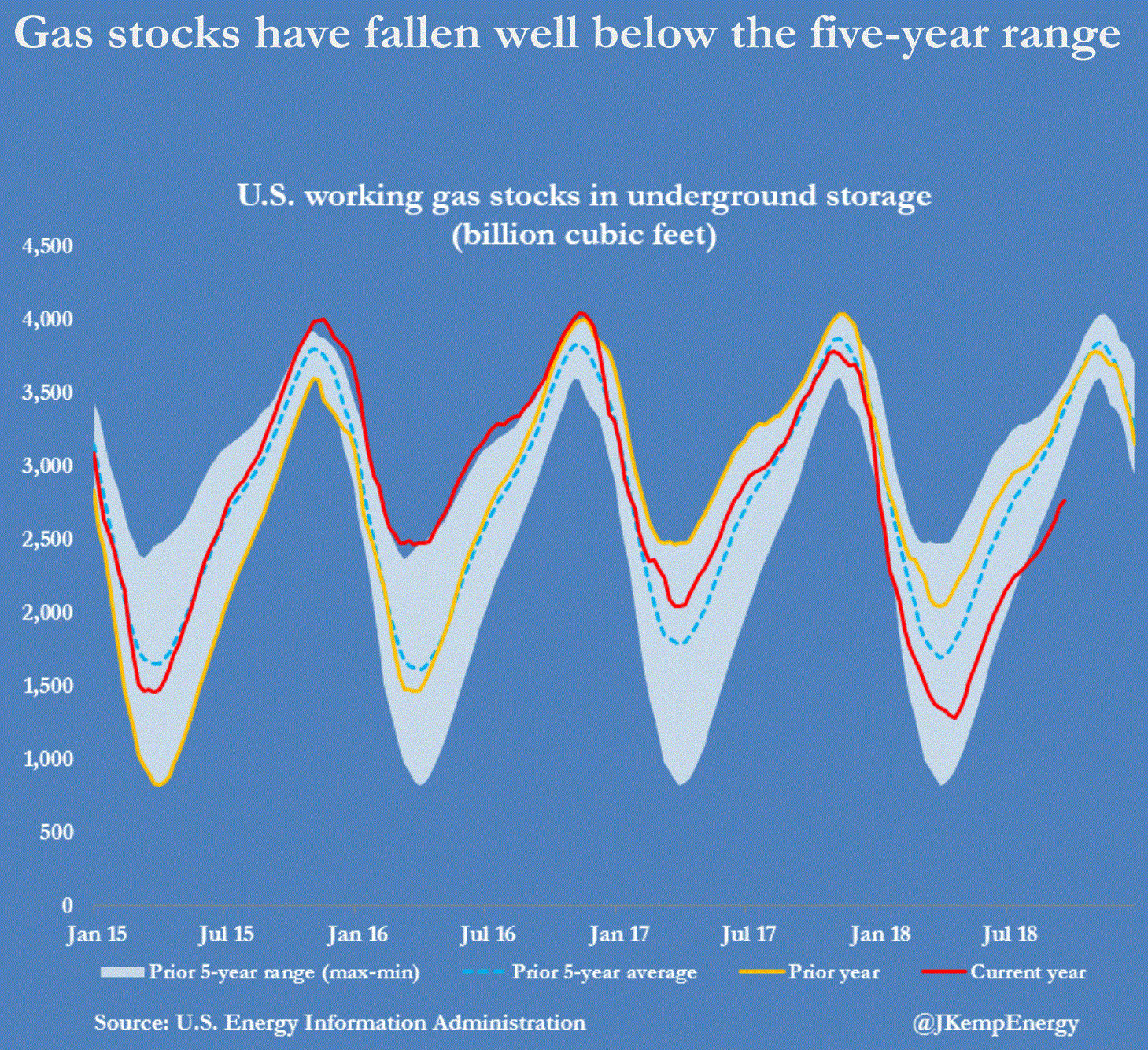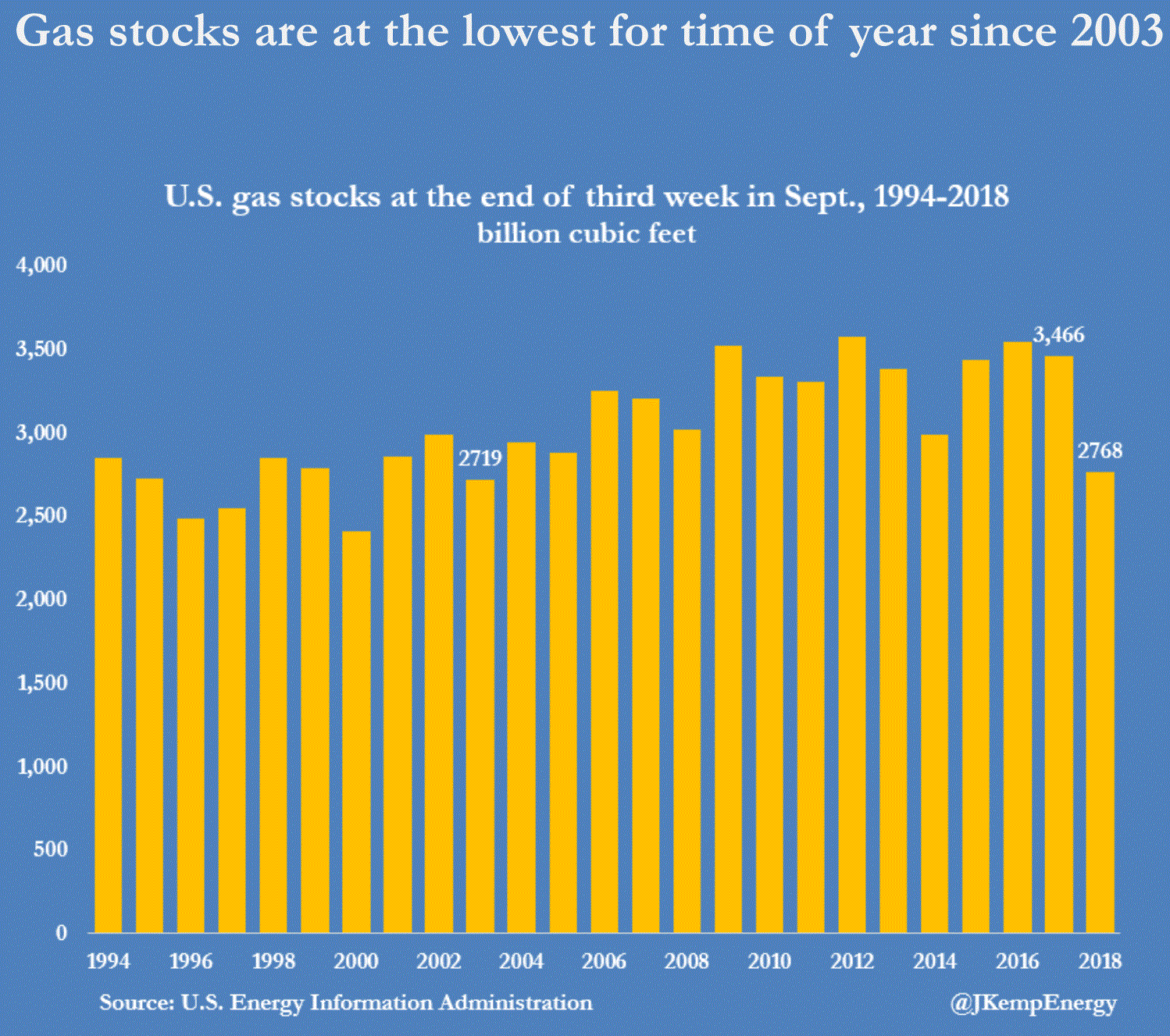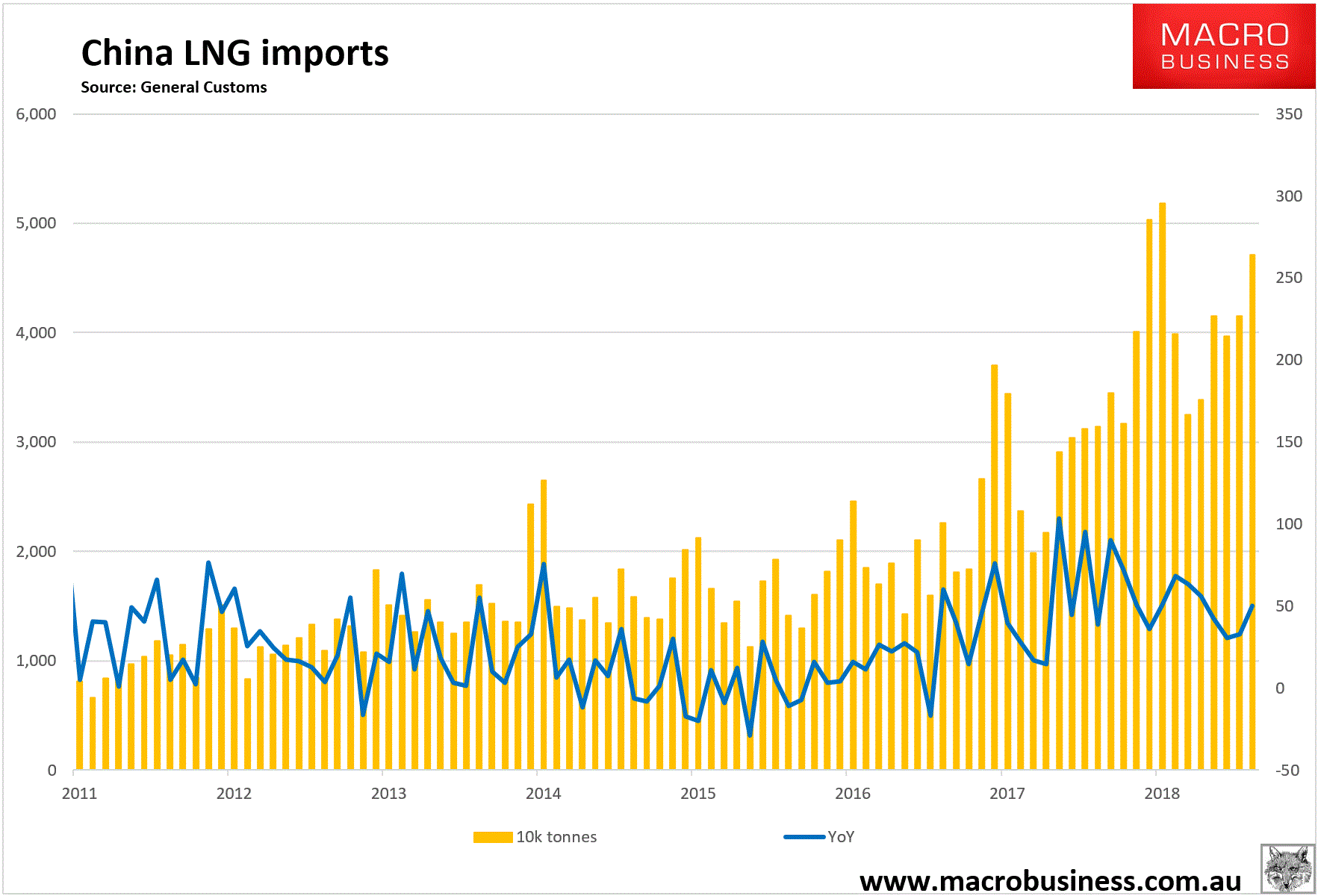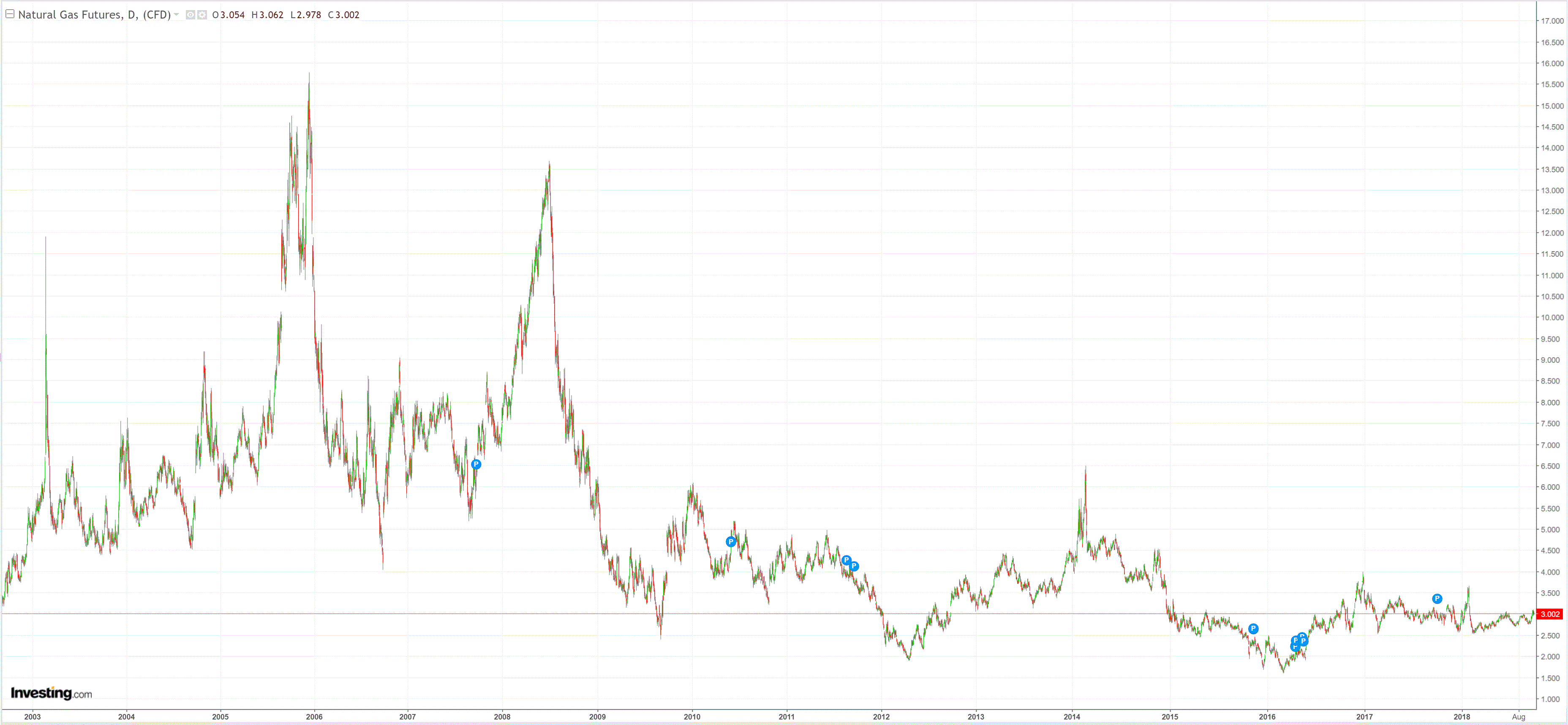Is Australia entering a new energy shock? There are two reasons why it might be. First, US gas reserves are their lowest since 2003, via John Kemp:


From Barrons:
Natural gas prices could spike this winter if there is a severe cold snap.
Gas stockpiles are expected to end the month of October at 3,330 to 3,370 billion cubic feet, the lowest level for an October month-end since 2005—making the market vulnerable to potential winter supply disruptions, according to a note published Thursday by Anthony Yuen, global energy strategist at Citi.
A severe cold spell could lift Henry Hub cash prices to a range of $12 to $16 per one million BTUs, “similar to where marginal generation costs of fuel oil and diesel would be,” Yuen wrote. Henry Hub is the major U.S. gas benchmark.
If bitter cold weather hits both the U.S. and “either Europe or Asia at the same time,” he added, “spot LNG [liquefied natural gas] prices could surge to $20/MMBTU at the extreme.” LNG is an internationally traded commodity, with the U.S. becoming an increasing large exporter. LNG is consumed in Asia and Europe.
The second reason is China, via Domainfax:
In its war on pollution, the Chinese government directed that 4 million households in northern China stop using coal and switch to clean energy for heating and cooking last year. Overzealous local officials converted 5 million households.
But as the freezing winter hit, the gas supplies ran short. Chinese media reported on schools in Hebei province where children developed frostbite in the classroom.
As another winter approaches, the Chinese government doesn’t want a repeat of last winter’s village backlash against the clean energy policy. And it is determined to reduce the use of coal – city residents demand blue skies. So imported gas has been stockpiled by China at an unprecedented rate.
“With the tariff on the US, Australian LNG will probably be the most important for spot volumes,” says Wood Mackenzie’s senior gas consultant in Beijing, Wen Wang.
She says “there isn’t enough LNG in the Asia Pacific region to meet China’s demand” for spot volumes – gas that is bought to meet immediate needs and outside of long-term contracts.
…According to Wen, Chinese gas companies are better prepared to avoid gas shortages this winter.
“There are new policies from the provincial governments that say supply needs to be in place before homes are converted. The target is less aggressive … This year the quota for switching is 2 million.”
Still, China’s LNG terminals will need to work at 120 per cent capacity to meet the “very ambitious demand for LNG” as the heating season kicks in.
Here’s the chart:

One might rightly ask why I’m looking at US supply and Chinese demand gas dynamics to determine whether or not an Australian energy shock is coming. But that’s our new reality since QLD opened its giant LNG export plants. We no longer set our own gas prices, the global market does. Because gas-powered generation sets the marginal cost of electricity on the east coast as well so the impact is compounded through power prices.
This last week, Asian spot LNG prices thankfully fell 60 cents $15.40Gj but the conditions are there for another price spike if the northern hemisphere sees a nasty winter.
The good news is that despite the high Asian prices and prospects, the local gas price is still hovering at $9-10Gj. Why? Only one reason: domestic gas reservation with Resources Minister Greg Canavan keeping the pressure on the QLD gas export cartel:
“We had productive discussions about the existing agreement between the Government and east coast LNG exporters to guarantee domestic supply for 2019 and options for ensuring supply in coming years.
“The gas industry recommitted to the Peak Electricity Demand Gas Supply Guarantee which ensures that there is sufficient gas available to keep the lights on at times of high electricity demand.
“There was also in principle support for recommitting to the Heads of Agreement that provides domestic gas users with a first option to buy uncontracted gas. The government will seek to finalise a new agreement with the industry in the coming weeks.
…Under the ADGSM there are a number of steps the Minister must undertake before export controls can be imposed for the following year, including making a notification of intent to make a determination on the state of the domestic gas market before 30 September. As part of this notification, the Minister can formally request information from LNG projects on their gas production outlook and planned export volumes, and from large gas users on their planned gas use and experiences with securing supply. A determination must then be made before 1 November 2018, on whether there will be a gas shortfall in 2019. If the Minister finds the domestic market is in shortfall, export permissions will be required by LNG exporters to continue to export LNG in a relevant market for the 2019 calendar year.
If we instead had LNG imports setting the east coast price today, which is the plan of four separate consortia and the suicidal NSW government, the local gas price would already be double at $18Gj and the power shock would be on its way to doubling as well. If the northern hemisphere winter is harsh and a China demand shock plus US supply shock arrive, then LNG imports would deliver an Australian east coast spot gas prices of $30-40Gj virtually overnight:

That’s the suicidal reality of LNG imports if they are left to set the marginal cost of energy on the east coast. They are not viable so long as gas reservation is in place so the intention of those behind the push is to destroy reservation.
Some will argue that the export income derived from such a price spike will outweigh the domestic income shock but that’s rubbish. Victoria University modelling showed long ago than the reverse is the truth. Plus, there is no increased tax take even if export prices rise because the firms have endless write-offs to hide behind and the Petroleum Resource Rent Tax’s (PRRT) carriage of capex costs is a standing joke.
Then there is this, from News:
THERE are serious concerns about the $13 billion takeover of an Australian energy company with experts warning it is “entirely the wrong move” with implications for national security and gas prices.
Australians are just starting to realise how much of the country’s electricity and gas assets are owned by Chinese-linked companies and the huge dominance they now have.
The latest move from Hong Kong-based company Cheung Kong Infrastructure (CKI) to take over Australian-owned company APA will give it control over 60 per cent of Australia’s gas pipelines.
CKI already owns a lot of gas pipelines, powerlines and electricity generators around Australia.
…But it gets even more interesting when you add the assets controlled by other Chinese companies, particularly another company called State Grid, which is a Chinese Government-owned company.
When you combine the assets of all the companies you start to understand why some experts are so worried.
Australians rely on pipelines and powerlines to transport electricity and gas around the country and into their homes. Transmission networks move the energy around the country and distribution networks are the smaller lines that deliver it into their homes.
If the APA takeover went ahead, 100 per cent of electricity transmission and distribution in three states and territories would be partly controlled by Chinese and Hong Kong interests, according to national security expert and Australian Strategic Policy Institute (ASPI) executive director Peter Jennings.
Chinese and Hong Kong companies would essentially have a stake in all the electricity powerlines that deliver energy to homes and businesses in Victoria, South Australia and ACT.
…“These decisions were taken back in the 1990s when a lot of these assets were privatised and China was less of a concern,” he said. “Cyber also wasn’t as big of a feature.”
“I know it’s an issue concerning a lot of people in the public service and national security community.”
Whether Li-Ka Shing’s CKI is a national security threat I will leave to others to decide. I will just observe that the Australian energy production system itself is now so comprehensively, some might say suicidally, reliant upon the troubled demand dynamics of China to source, set the price of, and transport our own gas and power that a renewed price shock is embedded in the system.
Yet it is easy enough to fix. Strengthen domestic reservation now. No more LNG projects. Ban LNG imports.

